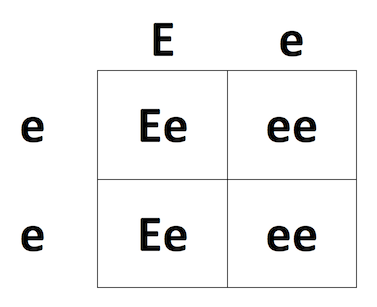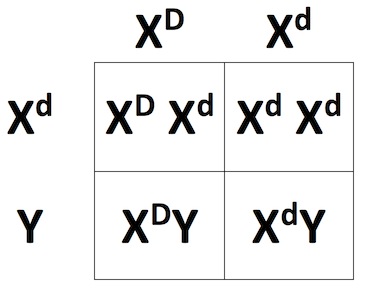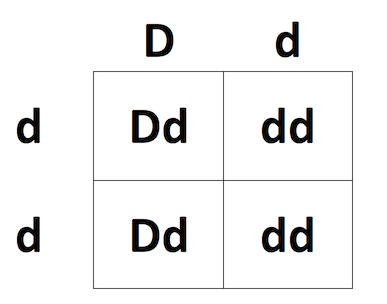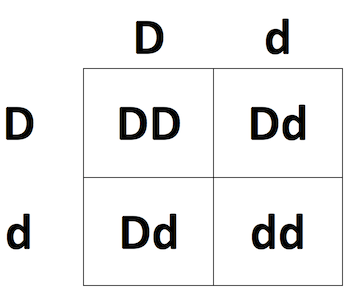4.4: Practice - Pedigrees
- Page ID
- 65146
\( \newcommand{\vecs}[1]{\overset { \scriptstyle \rightharpoonup} {\mathbf{#1}} } \)
\( \newcommand{\vecd}[1]{\overset{-\!-\!\rightharpoonup}{\vphantom{a}\smash {#1}}} \)
\( \newcommand{\dsum}{\displaystyle\sum\limits} \)
\( \newcommand{\dint}{\displaystyle\int\limits} \)
\( \newcommand{\dlim}{\displaystyle\lim\limits} \)
\( \newcommand{\id}{\mathrm{id}}\) \( \newcommand{\Span}{\mathrm{span}}\)
( \newcommand{\kernel}{\mathrm{null}\,}\) \( \newcommand{\range}{\mathrm{range}\,}\)
\( \newcommand{\RealPart}{\mathrm{Re}}\) \( \newcommand{\ImaginaryPart}{\mathrm{Im}}\)
\( \newcommand{\Argument}{\mathrm{Arg}}\) \( \newcommand{\norm}[1]{\| #1 \|}\)
\( \newcommand{\inner}[2]{\langle #1, #2 \rangle}\)
\( \newcommand{\Span}{\mathrm{span}}\)
\( \newcommand{\id}{\mathrm{id}}\)
\( \newcommand{\Span}{\mathrm{span}}\)
\( \newcommand{\kernel}{\mathrm{null}\,}\)
\( \newcommand{\range}{\mathrm{range}\,}\)
\( \newcommand{\RealPart}{\mathrm{Re}}\)
\( \newcommand{\ImaginaryPart}{\mathrm{Im}}\)
\( \newcommand{\Argument}{\mathrm{Arg}}\)
\( \newcommand{\norm}[1]{\| #1 \|}\)
\( \newcommand{\inner}[2]{\langle #1, #2 \rangle}\)
\( \newcommand{\Span}{\mathrm{span}}\) \( \newcommand{\AA}{\unicode[.8,0]{x212B}}\)
\( \newcommand{\vectorA}[1]{\vec{#1}} % arrow\)
\( \newcommand{\vectorAt}[1]{\vec{\text{#1}}} % arrow\)
\( \newcommand{\vectorB}[1]{\overset { \scriptstyle \rightharpoonup} {\mathbf{#1}} } \)
\( \newcommand{\vectorC}[1]{\textbf{#1}} \)
\( \newcommand{\vectorD}[1]{\overrightarrow{#1}} \)
\( \newcommand{\vectorDt}[1]{\overrightarrow{\text{#1}}} \)
\( \newcommand{\vectE}[1]{\overset{-\!-\!\rightharpoonup}{\vphantom{a}\smash{\mathbf {#1}}}} \)
\( \newcommand{\vecs}[1]{\overset { \scriptstyle \rightharpoonup} {\mathbf{#1}} } \)
\( \newcommand{\vecd}[1]{\overset{-\!-\!\rightharpoonup}{\vphantom{a}\smash {#1}}} \)
\(\newcommand{\avec}{\mathbf a}\) \(\newcommand{\bvec}{\mathbf b}\) \(\newcommand{\cvec}{\mathbf c}\) \(\newcommand{\dvec}{\mathbf d}\) \(\newcommand{\dtil}{\widetilde{\mathbf d}}\) \(\newcommand{\evec}{\mathbf e}\) \(\newcommand{\fvec}{\mathbf f}\) \(\newcommand{\nvec}{\mathbf n}\) \(\newcommand{\pvec}{\mathbf p}\) \(\newcommand{\qvec}{\mathbf q}\) \(\newcommand{\svec}{\mathbf s}\) \(\newcommand{\tvec}{\mathbf t}\) \(\newcommand{\uvec}{\mathbf u}\) \(\newcommand{\vvec}{\mathbf v}\) \(\newcommand{\wvec}{\mathbf w}\) \(\newcommand{\xvec}{\mathbf x}\) \(\newcommand{\yvec}{\mathbf y}\) \(\newcommand{\zvec}{\mathbf z}\) \(\newcommand{\rvec}{\mathbf r}\) \(\newcommand{\mvec}{\mathbf m}\) \(\newcommand{\zerovec}{\mathbf 0}\) \(\newcommand{\onevec}{\mathbf 1}\) \(\newcommand{\real}{\mathbb R}\) \(\newcommand{\twovec}[2]{\left[\begin{array}{r}#1 \\ #2 \end{array}\right]}\) \(\newcommand{\ctwovec}[2]{\left[\begin{array}{c}#1 \\ #2 \end{array}\right]}\) \(\newcommand{\threevec}[3]{\left[\begin{array}{r}#1 \\ #2 \\ #3 \end{array}\right]}\) \(\newcommand{\cthreevec}[3]{\left[\begin{array}{c}#1 \\ #2 \\ #3 \end{array}\right]}\) \(\newcommand{\fourvec}[4]{\left[\begin{array}{r}#1 \\ #2 \\ #3 \\ #4 \end{array}\right]}\) \(\newcommand{\cfourvec}[4]{\left[\begin{array}{c}#1 \\ #2 \\ #3 \\ #4 \end{array}\right]}\) \(\newcommand{\fivevec}[5]{\left[\begin{array}{r}#1 \\ #2 \\ #3 \\ #4 \\ #5 \\ \end{array}\right]}\) \(\newcommand{\cfivevec}[5]{\left[\begin{array}{c}#1 \\ #2 \\ #3 \\ #4 \\ #5 \\ \end{array}\right]}\) \(\newcommand{\mattwo}[4]{\left[\begin{array}{rr}#1 \amp #2 \\ #3 \amp #4 \\ \end{array}\right]}\) \(\newcommand{\laspan}[1]{\text{Span}\{#1\}}\) \(\newcommand{\bcal}{\cal B}\) \(\newcommand{\ccal}{\cal C}\) \(\newcommand{\scal}{\cal S}\) \(\newcommand{\wcal}{\cal W}\) \(\newcommand{\ecal}{\cal E}\) \(\newcommand{\coords}[2]{\left\{#1\right\}_{#2}}\) \(\newcommand{\gray}[1]{\color{gray}{#1}}\) \(\newcommand{\lgray}[1]{\color{lightgray}{#1}}\) \(\newcommand{\rank}{\operatorname{rank}}\) \(\newcommand{\row}{\text{Row}}\) \(\newcommand{\col}{\text{Col}}\) \(\renewcommand{\row}{\text{Row}}\) \(\newcommand{\nul}{\text{Nul}}\) \(\newcommand{\var}{\text{Var}}\) \(\newcommand{\corr}{\text{corr}}\) \(\newcommand{\len}[1]{\left|#1\right|}\) \(\newcommand{\bbar}{\overline{\bvec}}\) \(\newcommand{\bhat}{\widehat{\bvec}}\) \(\newcommand{\bperp}{\bvec^\perp}\) \(\newcommand{\xhat}{\widehat{\xvec}}\) \(\newcommand{\vhat}{\widehat{\vvec}}\) \(\newcommand{\uhat}{\widehat{\uvec}}\) \(\newcommand{\what}{\widehat{\wvec}}\) \(\newcommand{\Sighat}{\widehat{\Sigma}}\) \(\newcommand{\lt}{<}\) \(\newcommand{\gt}{>}\) \(\newcommand{\amp}{&}\) \(\definecolor{fillinmathshade}{gray}{0.9}\)Autosomal recessive trait
Query \(\PageIndex{1}\)
- Step-by-step solution
-
- Because the trait we are tracking (attached earlobes) is autosomal recessive, shaded individuals, like III-6, will have a homozygous recessive genotype (ee).
- If III-6 (ee) were to have a child with a man who was homozygous for unattached earlobes (EE), then all of the children would be heterozygous - getting one E from their father and one e from their mother.
Attached earlobes is a recessive trait and will only occur in ee genotypes. Heterozygotes (Ee) will have unattached earlobes, as that is the dominant condition. - The correct answer is
All of their children would have unattached earlobes.
Query \(\PageIndex{2}\)
- Step-by-step solution
-
- Because the trait we are tracking (attached earlobes) is autosomal recessive, shaded individuals, like I-2, will have a homozygous recessive genotype (ee).
I-1 must have a heterozygous genotype because he is able to pass on a recessive allele to some of his offspring (II-2 and II-4). - If I-1 and I-2 had another child, the cross would be:

Only offspring with ee genotypes will have attached earlobes (2/4 boxes).
\(2\div 4=0.5=50\%\) - The correct answer is
50%
- Because the trait we are tracking (attached earlobes) is autosomal recessive, shaded individuals, like I-2, will have a homozygous recessive genotype (ee).
Query \(\PageIndex{3}\)
- Step-by-step solution
-
- Individual I-1 is represented by a non-shaded square, indicating that it is a male with unattached earlobes.
- Because the trait we are tracking, attached earlobes, is autosomal recessive, shaded individuals will have a homozygous recessive genotype (ee).
Individuals that are non-shaded will have at least one E allele. - I-1 has children with attached earlobes (II-2 and II-4 are ee), meaning he must be able to pass on at least e allele. However, he shows the dominant condition, so he must also have one E allele.
Therefore, his genotype is Ee. - The correct answer is
Ee
Query \(\PageIndex{4}\)
- Step-by-step solution
-
- Individual II-3 is represented by a non-shaded square, indicating that it is a male with unattached earlobes.
- Because the trait we are tracking, attached earlobes, is autosomal recessive, shaded individuals will have a homozygous recessive genotype (ee).
Individuals that are non-shaded will have at least one E allele. - II-3 has a mother with attached earlobes (ee), meaning he must get one e allele from her. However, he shows the dominant condition, so he must also have one E allele.
Therefore, his genotype is Ee. - The correct answer is
Ee
X-linked recessive trait
Query \(\PageIndex{5}\)
- Step-by-step solution
-
- Individual I-2 is represented by a shaded circle, indicating that it is an affected female.
Therefore, she must have a homozygous recessive genotype of \(\text{X}^{d}\text{X}^{d}\). - Because males always get their \(\text{X}\) chromosome from their mother, all of the sons that individual 2 has will receive a recessive \(\text{X}^{d}\) allele.
Males will also receive their \(\text{Y}\) chromosome from their father, giving any son of individuals I-1 and I-2 a genotype of \(\text{X}^{d}\text{Y}\). - The correct answer is
100%
- Individual I-2 is represented by a shaded circle, indicating that it is an affected female.
Query \(\PageIndex{6}\)
- Step-by-step solution
-
- Unaffected males, such as individual II-1 have a genotype of \(\text{X}^{D}\text{Y}\).
On the other hand, affected males, such as individual II-3, have a genotype of \(\text{X}^{d}\text{Y}\).
Since males only have one \(\text{X}\) chromosome, they cannot be carriers. - Individuals II-4 and II-5 are both shaded in, indicating that they are affected.
In order to be affected, they must have the recessive genotypes \(\text{X}^{d}\text{Y}\) and \(\text{X}^{d}\text{X}^{d}\). This means that any child they have will have DMD because each parent can only pass on a recessive DMD allele. - Individual III-1 is an unaffected male, meaning that he has a genotype of \(\text{X}^{D}\text{Y}\).
If he mates with an unaffected, non-carrier female (\(\text{X}^{D}\text{X}^{D}\)), there is no chance that the children will inherit the DMD allele. - The correct answer is
If individual III-1 marries an unaffected, non-carrier female, none of their offspring will have DMD.
- Unaffected males, such as individual II-1 have a genotype of \(\text{X}^{D}\text{Y}\).
Query \(\PageIndex{7}\)
- Step-by-step solution
-
- Individual II-2 is represented by a non-shaded circle, indicating that it is an unaffected female.
- In order for individual II-2 to have a normal phenotype, but also produce an affected son, she must be a carrier for DMD. This means that she has one of each allele, \(\text{X}^{D}\text{X}^{d}\).
- The correct answer is
\(\text{X}^{D}\text{X}^{d}\)
Query \(\PageIndex{8}\)
- Step-by-step solution
-
- Individual I-3 is represented by a shaded square, indicating that it is an affected male. Therefore, he must have a genotype of \(\text{X}^{d}\text{Y}\).
If he has a child with a DMD carrier (\(\text{X}^{D}\text{X}^{d}\)), the cross would be:
- In order for a daughter to be affected, her genotype must be \(\text{X}^{d}\text{X}^{d}\).
Only one box has this genotype, so the chances of having an affected daughter is:
\(\dfrac{1}{4}=25\%\) - The correct answer is
25%
- Individual I-3 is represented by a shaded square, indicating that it is an affected male. Therefore, he must have a genotype of \(\text{X}^{d}\text{Y}\).
Autosomal dominant trait
Query \(\PageIndex{9}\)
- Step-by-step solution
-
- Because the trait we are tracking, dimples, is autosomal dominant, any shaded individuals will have at least one dominant allele (D).
Any unshaded individuals will have the recessive genotype (dd). - II-2 has dimples, meaning she must have at least one D allele. In addition, she has a recessive parent, and one of her children has no dimples (dd), so she must also have at least one d allele. This makes her genotype Dd.
Individual II-1 has no dimples, meaning that he must have a homozygous recessive genotype (dd). - Now that we know their genotypes, if we perform a cross between individuals II-1 and II-2 we find:

Only offspring with a D allele will have dimples (2/4 boxes).
\(2\div 4=50\%\) - The correct answer is
50%
- Because the trait we are tracking, dimples, is autosomal dominant, any shaded individuals will have at least one dominant allele (D).
Query \(\PageIndex{10}\)
- Step-by-step solution
-
- Phenotype is the physical characteristic that we see (ex: dimples).
A genotype is the allele combination (ex: DD) - Because the trait we are tracking is having dimples, shaded individuals, like III-4, have dimples. Unshaded individuals, like III-1, do not have dimples.
- The correct answer is
Dimples
- Phenotype is the physical characteristic that we see (ex: dimples).
Query \(\PageIndex{11}\)
- Step-by-step solution
-
- The trait that we are tracking, dimples, appears to be dominant, as all offspring who have the trait have an affected parent.
Having dimples also does not skip a generation, which suggests that it is likely dominant. - Shaded individuals have dimples, meaning that they must have at least one D allele.
Unshaded individuals, like I-1, do not have dimples, meaning that they must have the homozygous recessive genotype dd. - An individual with dimples can be either DD or Dd.
Individuals like II-2, II-3, and III-2 all have at least one recessive parent. Since the recessive parent can only donate a d, each of them must have a d in their genotype.
Because they all have dimples, we know they must have one D allele as well, giving them all the genotype of Dd. - The correct answer is
III-2 → Dd
- The trait that we are tracking, dimples, appears to be dominant, as all offspring who have the trait have an affected parent.
Query \(\PageIndex{12}\)
- Step-by-step solution
-
- Because the trait we are tracking (dimples) is autosomal dominant, any shaded individuals have at least one dominant allele (D).
Any unshaded individuals have the recessive genotype (dd). - Individual III-3 must be heterozygous (Dd) because he has an unshaded father (dd).
If he was to have a child with a woman who was heterozygous for dimples (Dd), then the cross would be:
- Dimples is a dominant trait and will occur whenever a dominant allele is present in the genotype.
Homozygous recessive individuals (dd) will have no dimples, as that is the recessive condition.
Looking at the Punnett square, we find that \(\dfrac{3}{4}=75\%\) offspring will have at least one D allele. - The correct answer is
75%
- Because the trait we are tracking (dimples) is autosomal dominant, any shaded individuals have at least one dominant allele (D).
Contributors and Attributions
Khan Academy (CC BY-NC-SA 3.0; All Khan Academy content is available for free at www.khanacademy.org)

